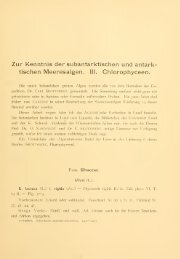Download PDF
Download PDF
Download PDF
You also want an ePaper? Increase the reach of your titles
YUMPU automatically turns print PDFs into web optimized ePapers that Google loves.
124<br />
ZYGNEMATACEAE<br />
insists that cell lengths are of no taxonomic importance since<br />
they may be mocJiiied in some species by environmental condi-<br />
tions. Nevertheless there are some species in which the cells are<br />
relatively short (one-half to two diameters), and others in which<br />
they are relatively long (eight to twenty-five diameters). In these<br />
species at least, the cell lengths may be contributory evidence to<br />
their identification. Cells 6oom long have been seen in at least<br />
5 species, the diameters of which are between 201^ and 45/^<br />
The chromatophores are ribbonlike or troughlike, with or<br />
without a median ridge, arranged in a left-handed, or counter-<br />
clockwise spiral in the parietal cytoplasm. The number of spirals<br />
in a cell may vary from one to sixteen. In some species the number<br />
of chromatophores is uniform. In others there are occasional cells<br />
in filaments with one more than the usual number— particularly<br />
in the one-spiraled species. How these arise is not known. In<br />
still other species the number regularly varies within certain limits.<br />
In determining the number of chromatophores in a given<br />
specimen, counts should be made only in filaments attached to<br />
the sporangia or gametangia being studied, as there may be vege-<br />
tative filaments of nearly the same dimensions but of another<br />
species present in any collection. In most species the number of<br />
spirals is readily determined by focusing just below an upper-half<br />
turn of the spiral, counting this turn as one and adding to it the<br />
number of optical intersections made by the spirals on the oppo-<br />
site side of the cell. In very large species and in those with tightly<br />
coiled chromatophores this may be impossible. In such species<br />
and in those with nearly straight chromatophores, the numbers<br />
are best determined by counting the ends of the spirals near the<br />
cross walls.<br />
Each chromatophore has from several to many disc-shaped<br />
pyrenoids spaced at regular intervals, and in certain species interrupting<br />
the median ridge. The margins of the chromatophores<br />
may be nearly smooth, or variously crenulate. Just after cell<br />
division the spiral pattern is continuous from one cell to the next,<br />
interrupted only by the thin partition wall. Chromatophores are<br />
examples of direct cytoplasmic inheritance. Through aplanospores<br />
they are derived directly from the chromatophores of the sporog-<br />
enous cells. Through zygospores they are derived from the chromatophores<br />
of the receptiue gametangia.<br />
The cells of a filament are enclosed in a pcctic sheath im to 17M




